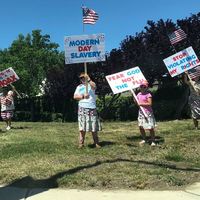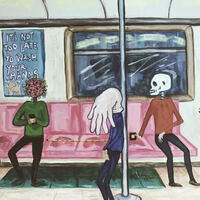NCPH-Peer-Review-Roundtable
"Collecting for COVID"
Friday, March 26th
3:30pm EDT
We here at JOTPY (our fond name for our international COVID-19 archive) are comprised of more than 300 archivists, faculty, staff, students, teachers, and public history practitioners and organizations. As of March 2021, we have more than 14,000 items in our collection.
Our NCPH panel is a bit unconventional. Instead of a traditional roundtable, we're encouraging you - our generous audience - to review our site and activities at this critical one-year mark.
We encourage you to explore the site widely, but there's a lot of materials to go through. To help focus your attention, we have laid out below some of the most common issues we confront. (These are also often the subject of our own internal debates, so we at least promise you a vibrant conversation.)
We encounter a host of issues relating to ethical considerations, from overt racism and disinformation, to the age of consent and the presence of revealing information. We encourage you to explore the items below for discussion during our NCPH session.
Racism & Disinformation

News story: Dolphins and swans reappear in Venice canals one week after city locks down
This news story appeared in the Evening Standard and stated that dolphins and swans had returned to the Venice canal. Though false, the article was added by a contributor who believed the article. The Evening Standard has since published an update stating that the claims were false. However, the URL for both versions of the article--truthful and fake--are identical.
The Cause of Covid
The item reflects both sinophobia and disinformation. To make this submission more complicated, it was contributed by a middle school student in response to a prompt from their teacher.
COVID IS FAKE!!!!!!!!
We believe that this contribution is satire based on mutiple conspiracy theories floating around the country. However, the author did not indicate that this post was satirical. What is the role of the curator to label intent rather than content?
Consent
There are two consent considerations.
1) As interest in teaching with the archive expanded to schools across the country, we received more an more contributions from minors. The legal age of consent for social media, apps, and other platforms (like JOTPY) is 13 years old.
2) JOTPY contains many posts of art and street art. When someone contributes their own art, are they automatically giving consent for reuse privileges? When someone contributes someone else's art (public or private), do we have the right to make their post public?

Covid-19 Protest in Tracy, CA
We posted this contribution and quickly received pushback from another archive user for not obscuring the face of the young girl in this photograph. We reviewed the submission and decided her face was obscured enough, and kept it public.

The Daily Commute
This contributor included their own art, which we later used for some promotional materials. We asked for permission, but did we need to?

A Map of San Francisco's New Street Art
A contributor included a link to an article about art created by artists involved in the Paint the Void initiative. Does public art automatically imply consent for contribution to a digital archive? We ultimately contacted the artists for permission before we made the post public.
Oral Histories
Some of our other considerations are about detailed information people include in their posts, but specifically their oral histories. Many include their home address. So long as that information is not included in the oral commentary, we can easily obscure the written information. Others include the full names of people close to the informant, but who did not otherwise consent (or are able to consent) to be in the archive. Others still include information about their health, the health of their friends and families, or their employers.
For obvious reasons, we are not including tangible examples of these here, but we encourage your probing questions about our challenges and solutions.
Archival Silences
JOTPY can certainly be considered a rapid response archive, but since the pandemic is on-going, collection is beginning to feel less like a sprint and more like a marathon. There are some benefits to long-term rapid response collection, however, including our ability to identify and attempt to fill archival silences. These often revolve around race, class, gender, and geography.
To wit, several instructors, internship supervisors, and teams of students have identified underrepresented groups and issued "calls" to fill those voids. Examples of these include:
- COVID-19 Survivors
- LGBTQ+ Communities
- Mental Health
- Native American & Indigenous Communities
- Rural Stories
- Social Justice
We'd love to know what you think about this strategy and where else we might have room to expand.
